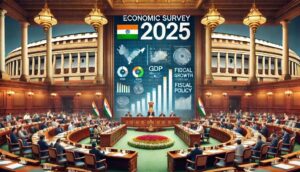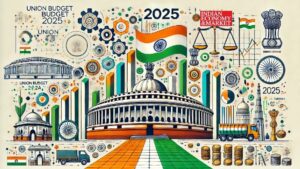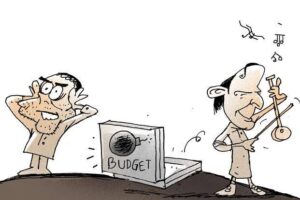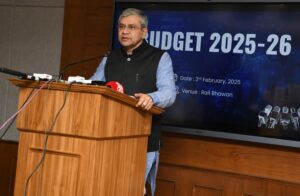Tax reforms for ‘Aam Aadmi’,more space for private sector
6 min read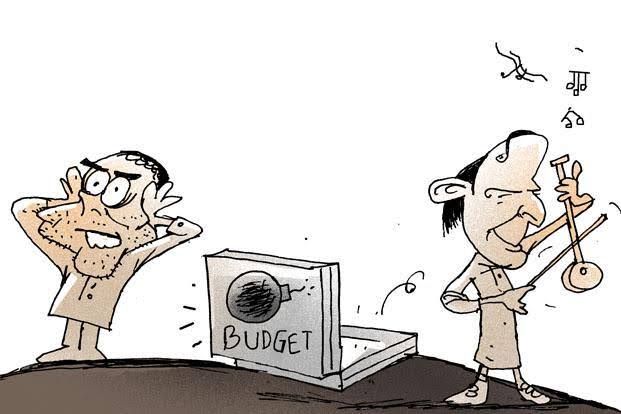
Makhana Republic: Viksit Bharat with ‘Deregulation’
By Aditya Trivedi / Harsh Mantri
Loud Opposition, an unexpected pause (periodic applause thereafter) and then the Speaker hints to start. This year’s budget appears to be development friendly aligned with the vision of Viksit Bharat 2047. Given that it has been only six months since the previous budget in July 2024, several references were made to that announcement. Notably, the July 2024 budget announced major projects for Bihar and Andhra Pradesh, this year Bihar finds multiple mentions, considering upcoming elections later this year while Andhra Pradesh was not allocated any specific schemes. However, the Finance Minister did reference renowned Telugu poet Gurajada Apparao while outlining the government’s long-term vision for the next five years.
Teaser in Economic Survey : Deregulation, Private Investment, and Growth Partnerships
After the release of Economic Survey 2024-25 it was anticipated that its key themes ‘deregulation’, private sector investment and energy transition would be reflected in this year’s budget. Staying true to these expectations, the budget initiated transformative reforms across six domains and focused on development of four powerful engines: Agriculture, MSME, Investment, and Exports. The Budget recommends formation of a High Level Committee on Regulatory Reforms to review all non-financial sector regulations, certifications and licensing requirements. Financial Stability and Development Council (FSDC) would evaluate the impact of current financial regulations and formulate a framework to enhance their responsiveness. To further improve the business environment, an Investment Friendliness Index of States will be introduced along with Jan Vishwas Bill 2.0 to decriminalise more than 100 provisions across various laws. Notably, throughout her speech, the Finance Minister repeatedly emphasized the phrases “in partnership with states” and “in partnership with the private sector,” signaling a collaborative approach to economic growth—an aspect that has been widely welcomed.
Engines of Growth: Strengthening Agriculture, MSMEs, Investment, and Exports
The Budget outlines four key engines of growth – agriculture, MSMEs, investment and exports. Despite geopolitical headwinds, confidence in India’s growth story remains strong. Budget places a strong emphasis on taxation, power sector, urban development, mining and regulatory reforms with special focus on the middle class and greater participation of the private sector.
A comprehensive programme for vegetables and fruits, focusing on nutrition of the citizens; setting up of a Makhana Board in Bihar; Mission for Cotton productivity, Poshan 2.0 etc. portrays the commitment of the government on sustainable and healthy consumption, along with welfare of farmers. The Economic Survey also highlighted the perils of ultra-processed foods and the need to curb its consumption. Measures like rural prosperity and resilience programmes; increase in kisan credit card limits; promoting urea production; enhancing agriculture financing will boost farm productivity, improve income security for farmers, and ensure long-term agricultural sustainability.
China plus one: Strengthening India’s Manufacturing Ecosystem
Recognising MSMEs as the second engine of growth after agriculture, the Finance Minister outlined a vision to position India as a global manufacturing hub. Technological upgradation and improved access to capital, including credit cards with limits upto 5 lakhs, Alternate Investment fund, Fund of Fund for startup ecosystem will improve the backbone of our economy. Focus on developing India to be a global hub for the toy sector – development of clusters, manufacturing ecosystem, high quality, unique, innovative, sustainable toys is a welcome step. With India banning Chinese toys in the past to facilitate development of the toy industry with ‘Make in India’ as focus, it will be a lucrative opportunity rewarding small scale entrepreneurs. Another sector which gained priority is the leather sector and footwear sector. The scheme is expected to facilitate employment for 22 lakh persons, generate turnover of 4 lakh crore and facilitate exports worth 1.1 lakh crore. With the National Manufacturing Mission, self-reliance in pulses and keeping sectors like food processing in focus, China plus one strategy seems to be working for us reducing dependency on imports while fostering domestic industrial growth.
Climate Change: Fostering green energy ecosystem
With a strong commitment towards climate friendly development, the Manufacturing Mission will support clean tech manufacturing in India. This will aim to enhance domestic value addition and strengthen our ecosystem for solar PV cells, EV batteries, motors and controllers, electrolyzers, wind turbines and other key components of green energy transition.
Innovation Led Education: Empowering youth and building a skilled workforce
Atal Tinkering Labs in government schools; broadband connectivity in government higher secondary schools and primary health centres under Bharat Net project; Bharatiya Bhasha Pustak for digital Indian language books for schools and higher education; expansion of capacity in IITs; expansion of medical education seats, etc. highlights government focus on innovation-led education and 100% skilled labour with meaningful employment. The introduction of the PM Research Fellowship for 10,000 youth is a commendable step towards fostering research and academic excellence.
Fueling growth: Strategic investments and Reforms
With ambitious initiatives like achieving 100GW nuclear energy by 2047 and a strong focus on R&D, the government is paving a new way for clean energy, transition fuels and sustainable development. With a major investment in infrastructure, development of greenfield airports, enhancement of UDAN scheme, mining reforms, urban sector reforms, power sector reforms, Jal Jeevan Mission, policies to recognise importance of gig workers in Indian ecosystem, etc., there is a lot to capitalise in India’s growth story. Enhancing reach of India Post Payments Bank to rural areas, introduction of gramin credit scorecard framework for public sector banks; model Bilateral Investment Treaty (BIT) to be made more investor friendly indicates a shift towards trust based economic governance framework.
Transforming Taxation: Empowering the Middle class for all inclusive growth
The Union Budget 2025 aims to usher in transformative reforms across six key domains, one of the most significant being the emphasis on taxation reform, which has been positioned as a crucial step toward realizing the vision of Viksit Bharat.
Finance Minister Nirmala Sitharaman, in her budget speech, announced that a new Income Tax Bill will be tabled next week, upholding the spirit of Nyaya (justice) and aimed at simplifying the tax system by reducing the existing law by half. Introduction of the “Trust first, scrutiny later” principle is a welcome step fostering confidence in the citizens.
Recognizing the pivotal role of the middle class in India’s economic growth, the government has reiterated its commitment to empowering this section of society. Since the introduction of the new tax regime in 2020, several moderations have been made to ensure a more balanced and beneficial structure. The latest revisions in slab rates will exempt incomes up to ₹12.75* lakh (*for salaried individuals) from taxation while also providing relief across all income brackets. However FM didn’t hesitate to clarify again that capital gains will not form part of this reduced taxation structure much to the dismay of 10 crore plus active capital market investors.
These changes will increase disposable income for the middle class, significantly easing their tax burden and stimulating household consumption, savings, and investments. The government estimates the financial impact of this measure at ₹1 lakh crore, effectively serving as a direct infusion into the economy. This is expected to create a multiplier effect, driving growth in the FMCG sector, boosting overall consumption, and encouraging discretionary spending—yielding long-term economic benefits in the years to come..
The new tax structure is designed to provide substantial savings for taxpayers across various income levels. As per the revised regime:
An individual earning ₹12 lakh annually will receive a tax benefit of ₹80,000, effectively exempting them from tax liabilities.
A taxpayer with an income of ₹18 lakh will benefit from a tax reduction of ₹70,000, which accounts for 30% of their previous tax liability.
A person earning ₹25 lakh will see a tax saving of ₹1,10,000, approximately 25% of their earlier tax obligation.
References from the July 2024 Budget: Continuing the Momentum
Referring to the July 2024 budget, the Finance Minister highlights establishing of National Centres for Excellence in Skilling. Promoting spiritual tourism, with special focus on sites associated with the life of Lord Buddha. Allocation of Rs 20,000 cr has been done for facilitating private sector driven research, development and innovation. Building on the proposals from the July Budget, urban sector reforms related to governance, municipal services, urban land, and planning will be incentivized. The Finance Minister also reaffirmed the government’s commitment to maintaining a declining fiscal deficit trajectory, with the fiscal deficit for FY 2024-25 projected at 4.8% of GDP, and an estimated reduction to 4.4% in FY 2025-26.
This year’s capital expenditure is ₹10.18 lakh crore, which is lower than last year’s allocation of ₹11.11 lakh crore. Notably, there were no separate announcements for the railways or the defence sector, which comes as a surprise. The Finance Minister emphasized investments through the Public-Private Partnership (PPP) model multiple times, signaling a shift towards greater private sector involvement in driving the capital expenditure cycle, which had thus far been primarily led by government spending.
(Aditya Trivedi is a Delhi-based lawyer and Partner, Analogue Legal ;and Harsh Mantri is a Ujjain-based practicing chartered accountant)

